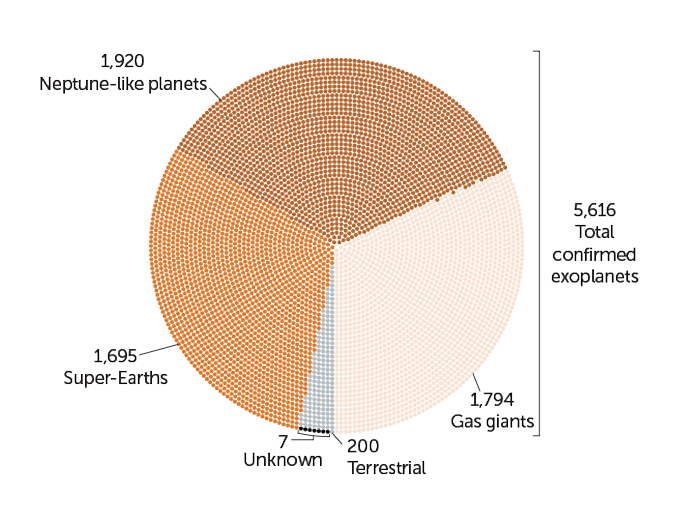Here are 5 exoplanet mysteries the James Webb telescope could help solve
This space telescope could reveal much about the formation, makeup and evolution of alien worlds
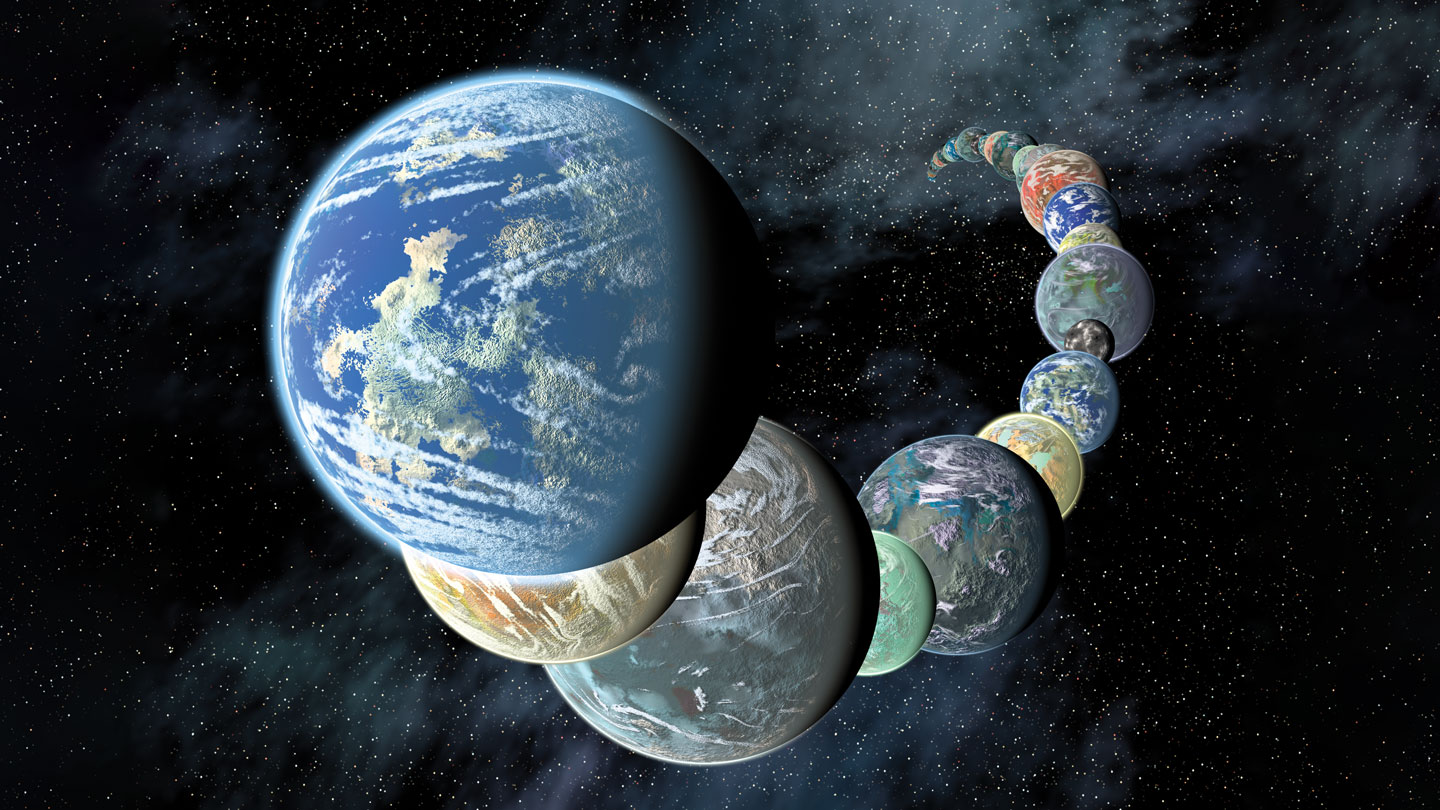
The James Webb Space Telescope will help astronomers answer key questions about planets beyond our solar system (illustrated). Among them: What are these planets are made of, and how do they form?
JPL-Caltech/NASA, R. Hurt/SSC-Caltech
By Elise Cutts
Finding planets around other stars used to be extremely difficult. In fact, scientists found the first black hole and countless distant galaxies before spotting any worlds beyond our solar system. The first exoplanet wasn’t discovered until 1992.
Now, astronomers have identified well more than 5,000 distant worlds. But we still know little about these exoplanets. Many illustrations show them with colorful volcanoes, oceans and cloud-streaked skies. Yet these features are still only guesses based on what scientists know about the worlds they’re studying. And often, the only data scientists have on those planets is their mass, width and distance from their star.
NASA’s James Webb Space Telescope, or JWST, is now unveiling dazzling new detail about these exoplanets. By collecting light from distant solar systems, JWST can pick out some of the specific gases in planets’ atmospheres. That includes water vapor, carbon dioxide, methane and other molecules.
Since JWST launched in 2021, it has peered at the atmospheres of hundreds of such worlds. Its targets range from gas giants to rocky orbs about the size of Earth.
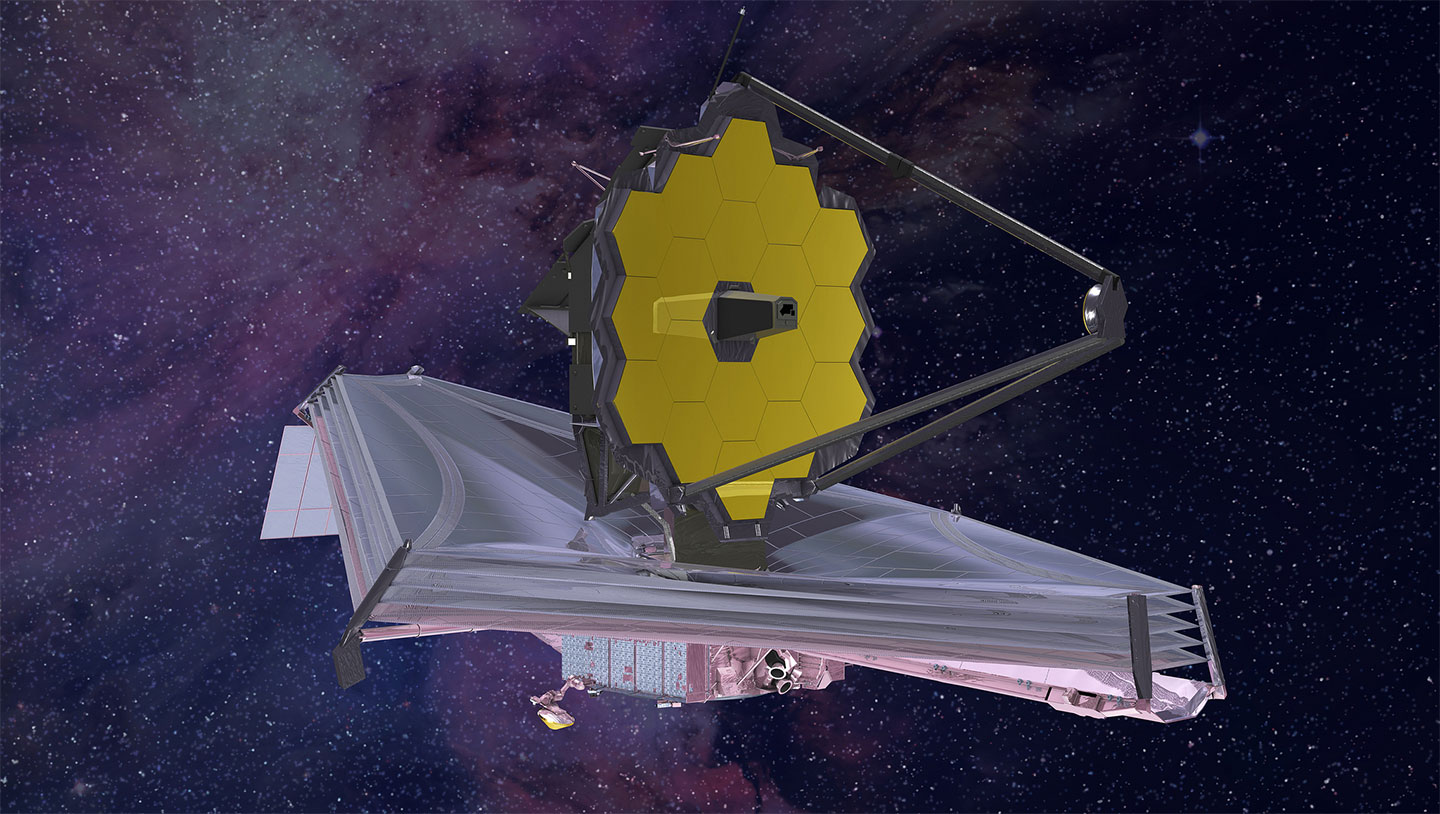
“There’s a lot of excitement about finding signatures of alien life,” says Laura Kreidberg. She’s an astronomer at the Max Planck Institute for Astronomy. That’s in Heidelberg, Germany. Like others, Kreidberg is excited about the prospect of finding hints of alien life. But, she adds, scientists have a lot to learn about planets before they can detect life on other worlds with confidence. JWST could help with that.
Most of what we know about planets today comes from the eight in our solar system. Over the next decade, JWST could collect data on a whole zoo of planets across the galaxy. These could include rocky worlds and gas giants like those in our solar system.
They might also include strange lava worlds or water worlds. Planets like these don’t exist in our solar system at all.
This wealth of new data could answer key questions about what exoplanets are made of and how they form. It might also tell us whether our solar system is like many others or an oddball.
Here are five big planetary puzzles that JWST could help solve.
Profiling exoplanet atmospheres
As an exoplanet orbits its star, it can pass (transit) between that star and Earth. That allows its star’s light to pass through the planet’s atmosphere on its way to Earth. Different gases in the exoplanet’s atmosphere will absorb different wavelengths of light. Scientists can tell what gases are in a planet’s atmosphere based on which wavelengths reach Earth and which don’t. Many gases, such as water vapor and CO2, absorb infrared light. This is the light to which JWST is sensitive. That has allowed the telescope to spot water, CO2 and other gases in exoplanet atmospheres.
Which rocky exoplanets have atmospheres?
Small, rocky planets — like Earth — are prime targets in the hunt for alien life. But if a rocky planet is going to host life, it needs an atmosphere. And scientists still aren’t sure what determines whether a rocky body can hold onto a blanket of gas.
In our solar system, there is a known divide between worlds with and without atmospheres. That divide can be imagined as a line that scientists call the “cosmic shoreline.” On one side of the line, there are worlds that get blasted with too much radiation from the sun and do not have strong enough gravity to hold onto an atmosphere. On the other side, there are worlds that get less solar radiation but have gravity strong enough to hold an atmosphere.
But does this type of “cosmic shoreline” exist for planets throughout the galaxy? To find out, scientists need to know which exoplanets have atmospheres and which don’t. This question may sound basic. But it’s only just now becoming possible to answer, thanks to JWST.
Air or no air?
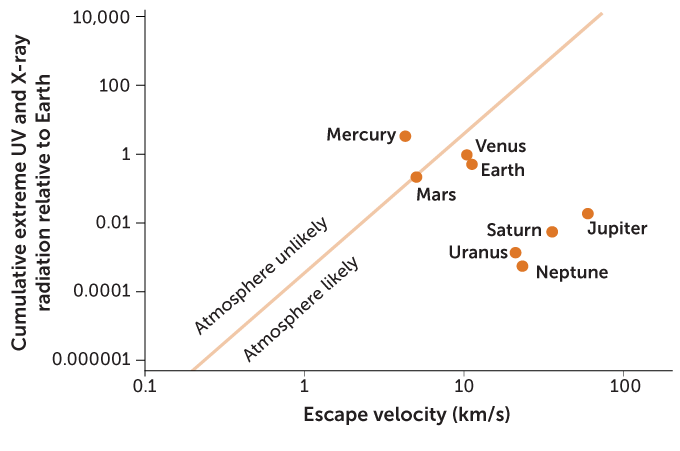
The cosmic shoreline is a theoretical dividing line between planets with and without atmospheres. It’s based on the relationship between how much gas-stripping radiation a planet gets from its star and the strength of its gravity. Solar system planets are shown.
Astronomers recently detected an atmosphere shrouding a rocky exoplanet for the first time. This 55 Cancri e is a bit bigger than Earth but much smaller than Neptune. That makes it a type of planet called a super-Earth. It orbits a sunlike star some 40 light-years away. JWST data suggest that 55 Cancri e has an atmosphere of carbon monoxide, carbon dioxide or a mix of the two with nitrogen.
The outlook is not as good for finding atmospheres on other rocky worlds. Specifically, those orbiting small, dim M-dwarf stars. These stars tend to spew bursts of atmosphere-stripping radiation more often than do stars like our sun.
The super-Earth LHS 3844b orbits an M-dwarf star. JWST has shown that this world is almost certainly a bare rock. The telescope’s observations of planets orbiting the M-dwarf star TRAPPIST-1 suggest that these planets are bare, too. It’s also possible these worlds just have very thin atmospheres, says Elsa Ducrot. This astronomer works at the Paris Observatory in France.
As JWST identifies more rocky planets with and without atmospheres, ideas about the cosmic shoreline can be tested.
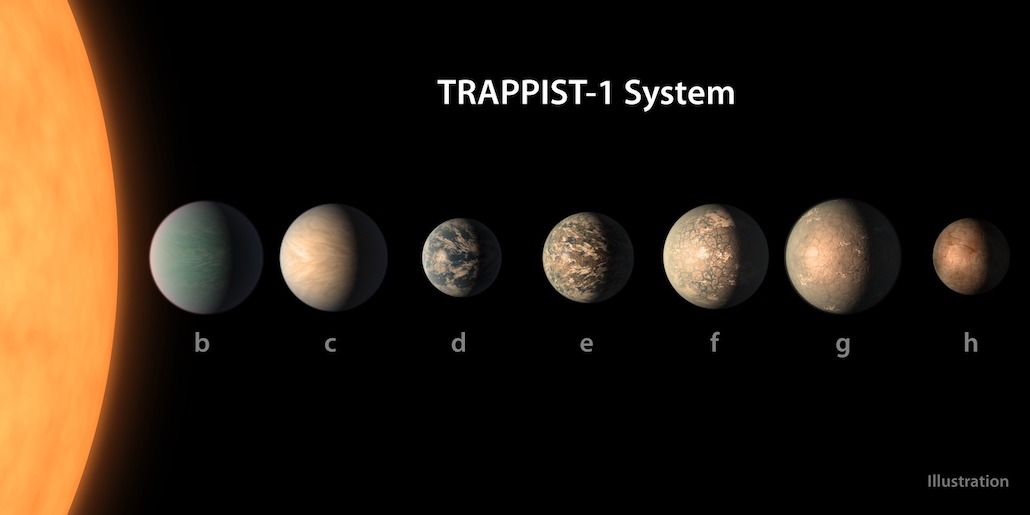
What is exoplanet terrain like?
Rocky exoplanets without atmospheres may not be suitable for life. But they will allow astronomers to study something that was impossible to probe directly before JWST. That is, what types of rocks make up the ground on exoplanets.
“I’m really excited about this,” Kreidberg says. “Of course, I want to see the atmospheres. But I think there’s a lot you can learn from the surface.”
Kreidberg and her team plan to use JWST to look for the chemical fingerprints of specific rocks on the rocky, airless super-Earth LHS 3844b. Learning what the planet’s surface is made of would be a powerful clue about the planet’s geology.
Finding signs of granite would be especially intriguing. Granite is a common rock on Earth. It forms from recycled and remelted rock. On our planet, this process depends in part on plate tectonics. But beyond Earth, granite appears to be extremely rare — likely because plate tectonics is too. Right now, there’s no more evidence for plate tectonics on other worlds than there is for alien life. So finding granite-like rock on an exoplanet would be a big deal.
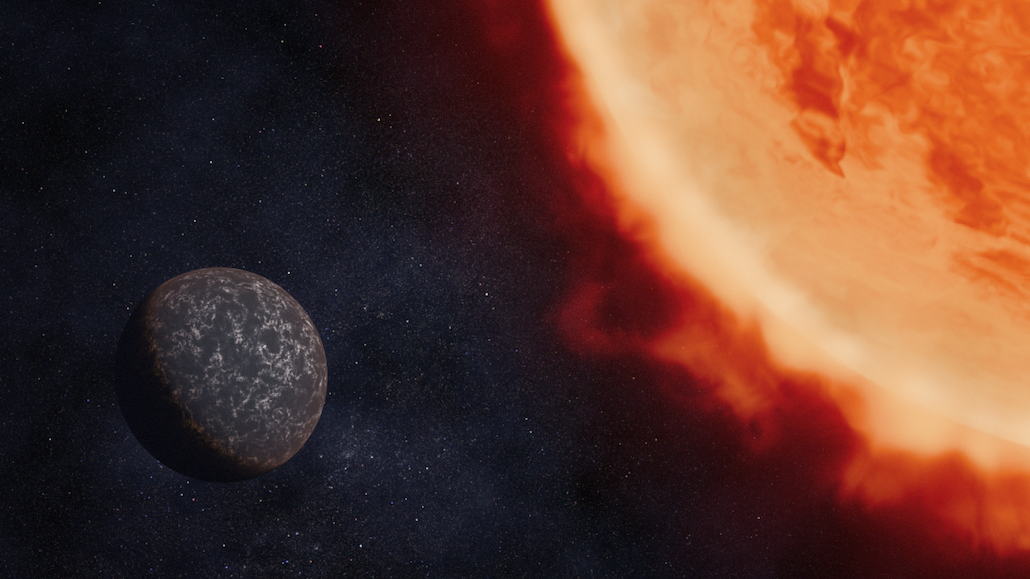
Astronomers are also seeking rocks that are more common in space than granite is. For instance, a surface covered in the black rock basalt would hint at the presence of volcanoes, like on many planets in our solar system. And if an exoplanet were found with rocks more like those in Earth’s mantle — such as peridotite — that could point to a recently frozen magma ocean. Or it might be home to exotic, super-hot volcanism.
JWST might even reveal the textures of rocks on exoplanet surfaces.
In our solar system, radiation from the sun wears down rocks on worlds without atmospheres. The result is a crumbly material called regolith. Worlds coated in this stuff have ragged, rough surfaces.
Kreidberg is part of a team that plans to look for regolith on LHS 3844b. They can do this by measuring how the planet’s brightness changes as it orbits its star. (Rough and smooth surfaces appear to reflect different amounts of sunlight coming in at shallow angles.)
A rough surface would suggest that regolith covers LHS 3844b. If it’s smooth, then perhaps volcanic eruptions keep coating the surface with new rock. Or maybe the planet’s M-dwarf star doesn’t weather planets the same way our sun does.
Super discoveries
Astronomers are hungry to learn more about a type of planet not found in our solar system: super-Earths. They’re bigger than Earth but smaller than Neptune (planets are shown to scale). JWST has already snooped on at least two super-Earths. The searingly hot LHS 3844b appears to lack an atmosphere. That should allow JWST to gather intel on surface geology. 55 Cancri e, another sizzler, has an atmosphere — the first detected around a rocky exoplanet.
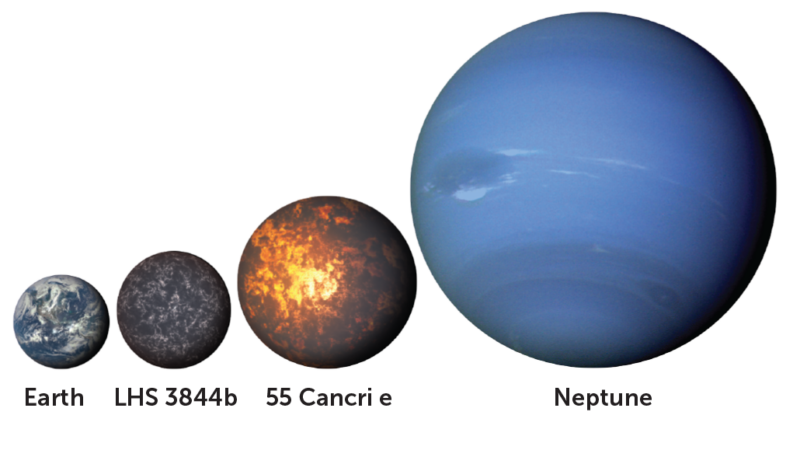
What are rocky exoplanets made of?
JWST might even offer a glimpse of the guts of exoplanets. How? By observing an extreme type of rocky world flooded with lava.
Such planets are hotter than Mercury. In fact, they hug their stars so closely that they can complete one orbit in mere hours. This causes the planets to become tidally locked. That means the same side of the planet always faces its sun. As a result, one side of the world freezes in endless night. The other melts into lava.
Magma oceans on the daysides of lava planets are a bit like windows. They show what’s inside the planets. Gases escaping the magma might give clues to what makes up the planet’s deep interior. And learning what planets are made of can tell astronomers a lot about how these bodies formed. It also can reveal whether their makeups and histories are similar to those of rocky planets in our solar system.
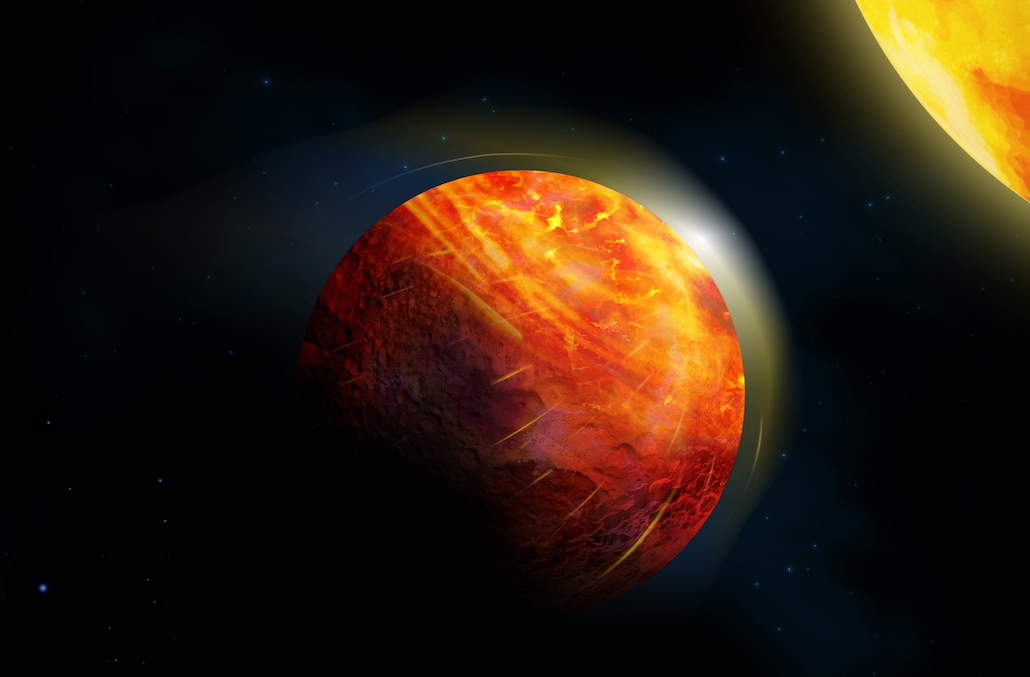
“You might be probing really deep — which is something that I think is hard to do even on Earth,” says Lisa Đặng. She’s an exoplanet scientist at the University of Montreal in Canada. There, she uses JWST to study blazing hot planets.
Thanks to their magma oceans, lava planets are thought to have atmospheres. Even if part of a lava planet’s atmosphere gets lost over time, gas released from magma should keep replacing it. Scientists haven’t yet detected whiffs of such gases. But Đặng is trying. She’s observing the lava world K2-141b. This super-Earth is about 200 light-years away.
A “lava planet is a special case of planetary formation,” Đặng says. “Oftentimes, some of the most extreme cases are the most revealing.”
What are sub-Neptunes?
What we know about Earth, Mercury and Mars can help astronomers imagine what alien rocky planets are like. But the most common type of planet in our galaxy — a sub-Neptune — isn’t found in our solar system.
They seem to be everywhere scientists look. Yet we still know very little about them, other than that their widths are a bit smaller than Neptune’s. Are they gas giants? Rocky planets? Something else entirely?
“They seem to be incredibly common,” says Joshua Krissansen-Totton. He’s an exoplanet scientist the University of Washington in Seattle. “We also really have no idea what they’re made of.”
Based on their masses and widths, sub-Neptunes might be mini ice giants. Such planets would be rich in ammonia, methane and water, like Neptune and Uranus are. But the same masses and widths could also fit planets with very different structures. Say, rocky cores wrapped in hydrogen and helium gas. Or exotic water worlds made mostly of different forms of H2O, not necessarily liquid.
JWST observations of sub-Neptune atmospheres could help pick out which idea is right.
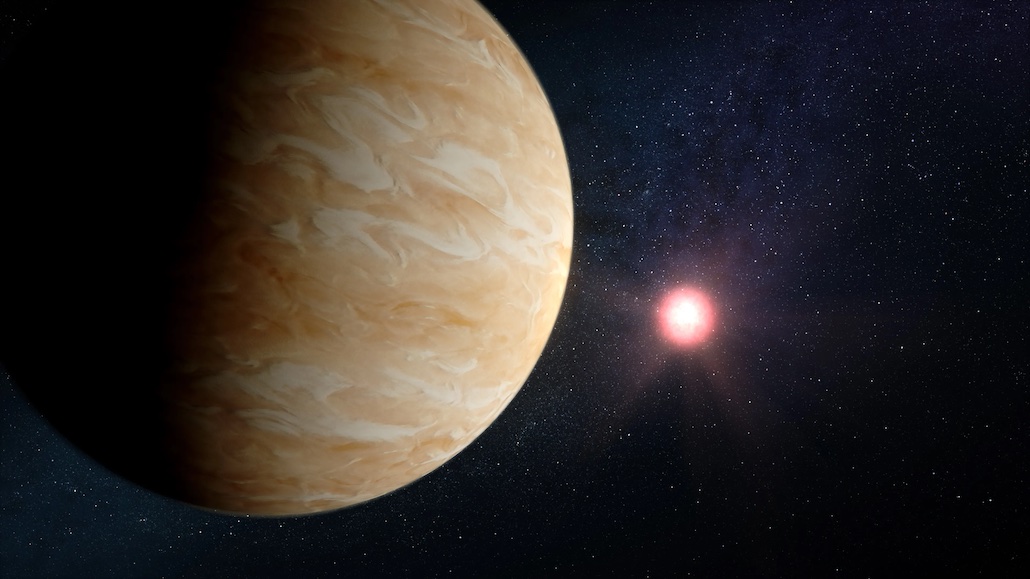
If sub-Neptunes do turn out to be gas-wrapped rocks, that could solve another mystery about the variety of planets in our galaxy. Namely: Our galaxy is home to many sub-Neptunes that are just a shade smaller than Neptune. It also has many super-Earths that are just a bit bigger than Earth. But very few planets have a size in between.
Perhaps this is because sub-Neptunes and super-Earths are actually the same type of planet. Scientists may just be spotting them at different points in their lifetimes. Sub-Neptunes could be rocks wrapped in hydrogen-rich atmospheres. But those planets lose their atmospheres over time. Super-Earths could be their leftover rocky cores.
Kreidberg’s team wants to look into that possibility. They’re using JWST to study the atmosphere of a planet called WASP-47e. Its width sits smack-dab in between Earth’s and Neptune’s. JWST could show what the planet is made of, and if it’s losing its atmosphere. This might help scientists figure out whether super-Earths really are the cores of sub-Neptunes.
Alien atmospheres
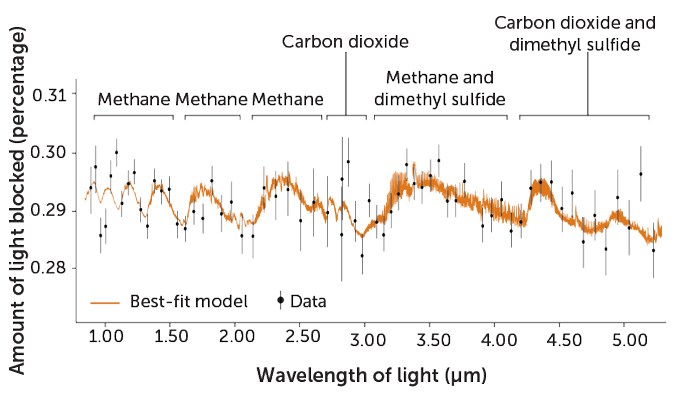
Using JWST, astronomers discovered methane, CO2 and dimethyl sulfide in the atmosphere of exoplanet K2-18b. They studied starlight that passed through the planet’s atmosphere to learn which wavelengths of light had been absorbed. That pointed to which gases were present in the atmosphere.
How do gas planets form?
Despite having four gas giants in our solar system, these puffy worlds are still quite mysterious.
“Essentially, it’s three questions,” says Ravit Helled. “How do gaseous planets form? How do they evolve? And what are they made of?” These are “fundamental questions in planetary science that we still haven’t answered.” Helled is a planetary scientist. She studies gas giants at the University of Zurich in Switzerland.
Scientists want to know whether gas giants form where we find them, or if they tend to wander over time. Planets can wander due to the gravity of other objects tugging at them. Those tugs could come from the disks of gas and dust around young stars (the raw materials for planets). Or wandering gas planets might wreak havoc, knocking other planets out of their orbits, while flinging around comets and asteroids. That chaos could have serious impacts on the stability — and habitability — of smaller worlds.
Do you have a science question? We can help!
Submit your question here, and we might answer it an upcoming issue of Science News Explores
JWST could provide a vital clue to how much gas giants wander in other solar systems. In general, planets that form farther from their stars have heavier elements in their atmospheres. JWST could observe enough gas-giant atmospheres to reveal where these planets tend to form and end up.
Scientists also want to learn whether warm gas giants form in the same way as cool ones. JWST can mostly see planets close to their stars. So the gas planets it can observe are much toastier than Jupiter, Saturn, Uranus and Neptune. It’s not yet clear whether these warm planets are just hotter versions of the gas giants in our solar system. They might be a different type of planet altogether.
Some of these questions could be settled soon. Since gas giants are so big, they’re much easier to study than small, rocky planets. With JWST, astronomers will soon have data on the atmospheres of enough gas giants to test ideas about how they form and evolve.
“The key is that we are going to have a large number of planets,” Helled says. “Until JWST, it was a handful of objects. But once we have more and the measurements are accurate, we can start to understand trends.” To her, “This is the power of JWST.”
Inventory of exoplanets
Astronomers have discovered more than 5,600 exoplanets. Most are Neptune-like (including the slightly smaller sub-Neptunes), gas giants or super-Earths (larger than Earth but smaller than Neptune). Far fewer small terrestrial planets like Earth have been found.
